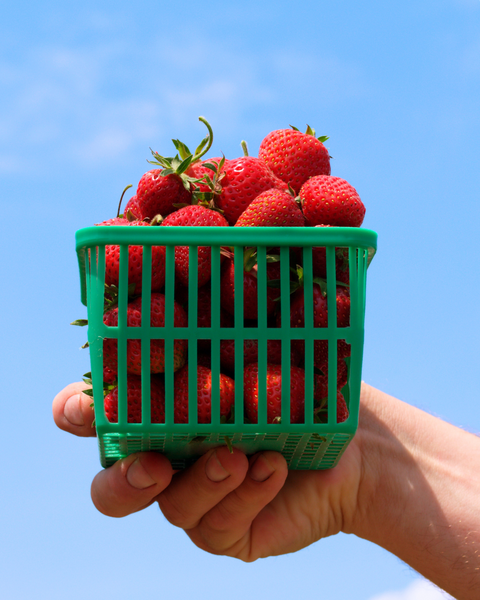Organizing a Pick-Your-Own
Pick-your-own (PYO) farms provide community, educational value, and fun—with delicious fresh produce included! Unsurprisingly, we receive inquiries from customers interested in setting up a PYO operation each year. Proper planning and investment can make your PYO operation rewarding and profitable. We have compiled the following considerations to help guide you and set you up for success when organizing a PYO.
Note: This is not a comprehensive list of everything you'll need to consider when organizing a PYO operation, but rather a rough overview to help you get started.
Variety Selection
Selecting the best varieties for your planned operation is crucial for its success; you need productive varieties that thrive in your location.
What type of fruit do you want to offer?
Our customers have great success with strawberry, raspberry, blackberry, and blueberry pick-your-own operations. These berries are popular and suitable for direct-to-consumer marketing, making them excellent choices for PYO operations.
But don't be afraid of offering something different at your PYO farm: currants, gooseberries, or asparagus. These products present a quirkiness that makes them stand out—in the best possible way! Offering these fruits or vegetables allows customers to experience and immerse themselves in something new or uncommon.
Currants, gooseberries, and asparagus can be a smart addition to the offerings at a strawberry, raspberry, blackberry, or blueberry PYO operation. To help extend your picking season, you can select varieties that ripen at different times than your other fruits.
How many weeks do you want to offer PYO?
Depending on your decision for the length of your farm's operating schedule, consider varieties that will help cover a short or long season's harvest. Factors that can affect your operating schedule decision:
- Resources
- Public Interest
- Staffing
- Farmworkers: staff for planting, pruning, harvesting
- Customer service: staff for greeting and checking out customers
- Guides and educators: staff knowledgeable about the crops, history of the PYO, and how to pick fruit
Site Selection
It is crucial to pick a site convenient for you and your customers. Your selected site needs well-draining soil and an irrigation source. Plants grow best in healthy, fertile soil. We strongly encourage conducting soil sample tests to assess your soil's health and nutrient levels every one to three (1–3) years.
Evaluate and assess a parking lot plan. Parking near the picking fields is generally more efficient but not always feasible. Instead, you may offer wagon rides to and from the fields or create a walking path. These methods require additional management considerations.
Facilities and Infrastructure
A few things are considered a "must-have" at your PYO farm:
- Checkout stand with a cash register
- Storage for holding fruit containers
- Bathrooms
- Handwashing stations
- Trash receptacles
Things to help elevate your PYO:
- Concession stand
- Shade and/or rest areas
- Clear and creative signage
- Play area for children
Marketing and Advertising
Pairing a strong community presence with quality promotion is key to your PYO's success. Building and fostering a loyal customer base is essential—you want them coming back season after season! Growing with your community can include cultivating email newsletters to stay connected, actively listening and responding to feedback, and supporting and collaborating with local businesses.
A professional website and active social media accounts are vital for providing information about hours, availability, and special events. Social media reaches new customers and gives viewers a glimpse of what your farm offers. Don't underestimate the pull of a good post!
Advertising can help draw in visitors to your PYO. Depending on your location and community base, you can do local advertising (i.e., flyers, posters, radio ads, local newspapers), digital advertising (i.e., Google ads, Facebook, Instagram), or a combination of both. You want to select advertising methods that will help you reach the most customers possible.
Added Amenities
When venturing into agrotourism, you often must sell more than just your fruit. You're selling an experience—a family outing turned tradition, a friend hangout, or a first date. Consider if you can plan any seasonal activities or offer amenities that'll cause people to rush to create a reminder on their calendars. We've seen success with amenities such as:
- Events
- Welcome new and returning customers by hosting harvest festivals, live music from local bands, hayrides, corn mazes, craft days, and educational workshops.
- Concession Stands
- Offering refreshments and snacks can improve the visitor experience and add revenue. Your concession stand can be as simple as selling nonperishable items like small chip bags and water bottles or more advanced by selling prepared foods or alcohol. Beer, wine, and cider gardens may entice visitors to come and spend a few hours at your establishment. Check with local authorities to ensure you adhere to all rules and regulations and obtain the necessary licenses and certifications.
Pricing
When determining the price of your fruit, remember that you're providing fresh, quality berries and a memorable experience. Survey the competition in your area and conduct additional market research to decide on a pricing range.
You must decide whether to sell by the pound or by the container. If selling by the pound, remember that you need a scale!
Contemplate if you want to run discounts such as 10% off for senior citizens or on Tuesdays.
Questions? Contact us!
Nourse Farms is here to grow with you every step of the way! We are happy to assist you in selecting the best varieties for your needs and provide any additional information you may need. Contact Anne Kowaleck with questions by phone at (413) 665-2658 ext. 201 or email at akowaleck@noursefarms.com.



